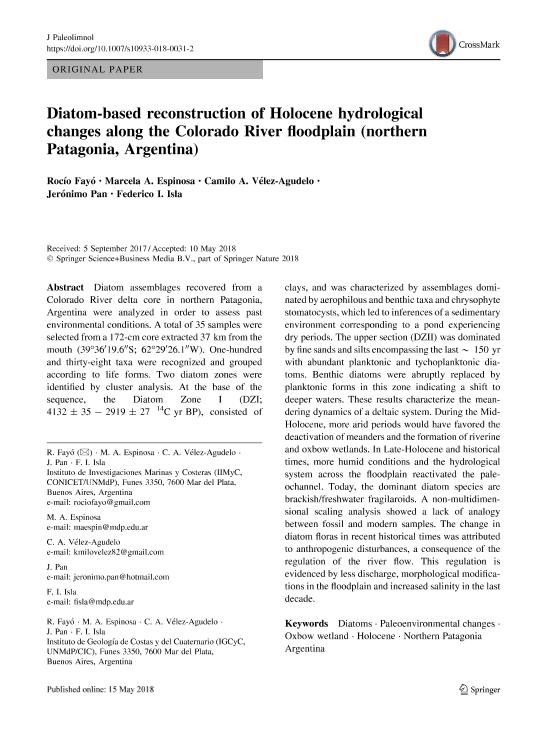Mostrar el registro sencillo del ítem
dc.contributor.author
Fayó, Rocío

dc.contributor.author
Espinosa, Marcela Alcira

dc.contributor.author
Vélez Agudelo, Camilo Andrés

dc.contributor.author
Pan, Jeronimo

dc.contributor.author
Isla, Federico Ignacio

dc.date.available
2019-11-07T15:37:42Z
dc.date.issued
2018-05-10
dc.identifier.citation
Fayó, Rocío; Espinosa, Marcela Alcira; Vélez Agudelo, Camilo Andrés; Pan, Jeronimo; Isla, Federico Ignacio; Diatom-based reconstruction of Holocene hydrological changes along the Colorado River floodplain (northern Patagonia, Argentina); Springer; Journal Of Paleolimnology; 60; 3; 10-5-2018; 427-443
dc.identifier.issn
0921-2728
dc.identifier.uri
http://hdl.handle.net/11336/88146
dc.description.abstract
Diatom assemblages recovered from a Colorado River delta core in northern Patagonia, Argentina were analyzed in order to assess past environmental conditions. A total of 35 samples were selected from a 172-cm core extracted 37 km from the mouth (39°36′19.6″S; 62°29′26.1″W). One-hundred and thirty-eight taxa were recognized and grouped according to life forms. Two diatom zones were identified by cluster analysis. At the base of the sequence, the Diatom Zone I (DZI; 4132 ± 35 − 2919 ± 27 14C yr BP), consisted of clays, and was characterized by assemblages dominated by aerophilous and benthic taxa and chrysophyte stomatocysts, which led to inferences of a sedimentary environment corresponding to a pond experiencing dry periods. The upper section (DZII) was dominated by fine sands and silts encompassing the last ~ 150 yr with abundant planktonic and tychoplanktonic diatoms. Benthic diatoms were abruptly replaced by planktonic forms in this zone indicating a shift to deeper waters. These results characterize the meandering dynamics of a deltaic system. During the Mid-Holocene, more arid periods would have favored the deactivation of meanders and the formation of riverine and oxbow wetlands. In Late-Holocene and historical times, more humid conditions and the hydrological system across the floodplain reactivated the paleochannel. Today, the dominant diatom species are brackish/freshwater fragilaroids. A non-multidimensional scaling analysis showed a lack of analogy between fossil and modern samples. The change in diatom floras in recent historical times was attributed to anthropogenic disturbances, a consequence of the regulation of the river flow. This regulation is evidenced by less discharge, morphological modifications in the floodplain and increased salinity in the last decade.
dc.format
application/pdf
dc.language.iso
eng
dc.publisher
Springer

dc.rights
info:eu-repo/semantics/openAccess
dc.rights.uri
https://creativecommons.org/licenses/by-nc-sa/2.5/ar/
dc.subject
Diatoms
dc.subject
Paleoenvironmental changes
dc.subject
Oxbow wetland
dc.subject
Holocene
dc.subject
Northern Patagonia Argentina
dc.subject.classification
Geología

dc.subject.classification
Ciencias de la Tierra y relacionadas con el Medio Ambiente

dc.subject.classification
CIENCIAS NATURALES Y EXACTAS

dc.title
Diatom-based reconstruction of Holocene hydrological changes along the Colorado River floodplain (northern Patagonia, Argentina)
dc.type
info:eu-repo/semantics/article
dc.type
info:ar-repo/semantics/artículo
dc.type
info:eu-repo/semantics/publishedVersion
dc.date.updated
2019-10-24T19:10:32Z
dc.journal.volume
60
dc.journal.number
3
dc.journal.pagination
427-443
dc.journal.pais
Alemania

dc.journal.ciudad
Berlín
dc.description.fil
Fil: Fayó, Rocío. Consejo Nacional de Investigaciones Científicas y Técnicas. Centro Científico Tecnológico Conicet - Mar del Plata. Instituto de Investigaciones Marinas y Costeras. Universidad Nacional de Mar del Plata. Facultad de Ciencias Exactas y Naturales. Instituto de Investigaciones Marinas y Costeras; Argentina
dc.description.fil
Fil: Espinosa, Marcela Alcira. Consejo Nacional de Investigaciones Científicas y Técnicas. Centro Científico Tecnológico Conicet - Mar del Plata. Instituto de Investigaciones Marinas y Costeras. Universidad Nacional de Mar del Plata. Facultad de Ciencias Exactas y Naturales. Instituto de Investigaciones Marinas y Costeras; Argentina
dc.description.fil
Fil: Vélez Agudelo, Camilo Andrés. Consejo Nacional de Investigaciones Científicas y Técnicas. Centro Científico Tecnológico Conicet - Mar del Plata. Instituto de Investigaciones Marinas y Costeras. Universidad Nacional de Mar del Plata. Facultad de Ciencias Exactas y Naturales. Instituto de Investigaciones Marinas y Costeras; Argentina
dc.description.fil
Fil: Pan, Jeronimo. Consejo Nacional de Investigaciones Científicas y Técnicas. Centro Científico Tecnológico Conicet - Mar del Plata. Instituto de Investigaciones Marinas y Costeras. Universidad Nacional de Mar del Plata. Facultad de Ciencias Exactas y Naturales. Instituto de Investigaciones Marinas y Costeras; Argentina
dc.description.fil
Fil: Isla, Federico Ignacio. Consejo Nacional de Investigaciones Científicas y Técnicas. Centro Científico Tecnológico Conicet - Mar del Plata. Instituto de Investigaciones Marinas y Costeras. Universidad Nacional de Mar del Plata. Facultad de Ciencias Exactas y Naturales. Instituto de Investigaciones Marinas y Costeras; Argentina
dc.journal.title
Journal Of Paleolimnology

dc.relation.alternativeid
info:eu-repo/semantics/altIdentifier/url/https://link.springer.com/article/10.1007%2Fs10933-018-0031-2
dc.relation.alternativeid
info:eu-repo/semantics/altIdentifier/doi/http://dx.doi.org/10.1007/s10933-018-0031-2
Archivos asociados
